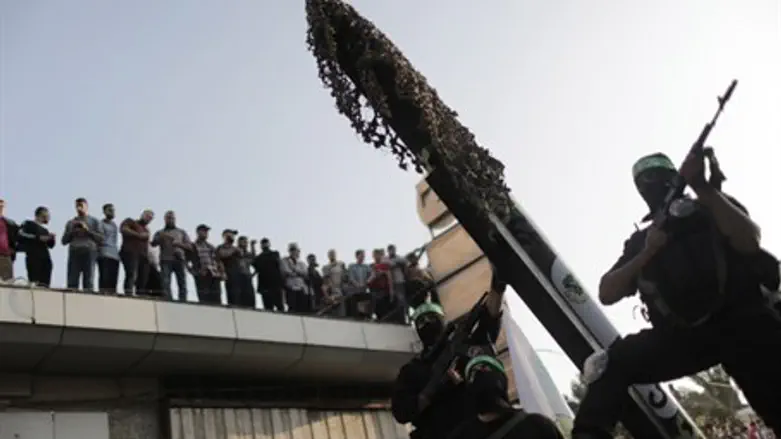
Just over a year-and-a-half has passed since Israel's government agreed to a ceasefire with the Hamas terrorist organization in August 2014, ending Operation Protective Edge, but new Israeli assessments indicate Hamas has already fully restocked its missile arsenal.
The appraisal, reported by Walla on Friday, notes that most of the missiles that bring Hamas back to the amount it had before it launched its third terror war on the Jewish state are of a shorter-range, and are domestically produced and therefore of a lower quality.
Back in June 2014 the terror group had around 12,000 rockets of various ranges, including long-range missiles. According to reports Hamas used around 4,600 of its rockets during the Operation, and another 4,000 or so were destroyed in Israeli strikes, leaving the terrorists with a third of their arsenal by the end of the fighting.
But in the 18 months that have passed, Hamas has worked intensively to rebuild its military capabilities while largely ignoring the civilian population in Gaza that continues to suffer from poor conditions, to the point that the UN has estimated Gaza will be "unlivable" by 2020.
Hamas has been rebuilding its terror tunnel system breaching into Israel, and likewise has ramped up its domestic production of rockets given that the Israeli naval blockade and Egyptian construction of a buffer zone has largely cut off the influx of weapons to the terrorists. However, Hamas is unceasing in its efforts to illegally smuggle in materials for building weapons and digging tunnels.
In addition to the many short-range missiles held by Hamas it has added many mortar shells, which were proven to be lethally effective in the last round of fighting. While of a much shorter range than rockets, mortars are easier to transport, quicker to fire and are not detectable under Israel's Color Red warning system.
Israel estimates that the number of Hamas terrorists and members of the various Hamas mechanisms in Gaza including its civilian police force stands at roughly 40,000 people. Around half of that number are members of the terror group's Al-Qassam Brigades, with around 1,000 of them working on the tunnel digging project.
Mohammed Deif remains the terror chief for Hamas, after having survived a sixth assassination attempt by Israel against him during Protective Edge, and is playing a key role in rebuilding the terror group's capabilities. Deif is supported by Yahya Sanwar, who serves as a sort of "defense minister" for him - Sanwar sat in an Israeli jail for 22 years before being released in the 2011 Shalit deal.
Deif, who is missing his legs from previous assassination attempts, had his wife and son killed in the strike that missed him during the Operation.
According to a report as Protective Edge wound down, Israel delayed striking Deif for three full days when it had concrete information on his whereabouts due to a ceasefire agreement, thereby missing the chance to take out the elusive terrorist - even though Hamas had breached numerous ceasefires during the war.
Amos Yadlin, formerly the head of Military Intelligence, revealed in August 2014 that in the last attempt on Deif's life in 2006, "instead of a one ton bomb, we decided to shoot two quarter ton bombs in order to avoid hitting innocent civilians. One of them didn't explode, and Deif survived."